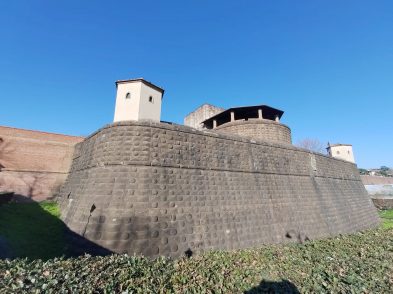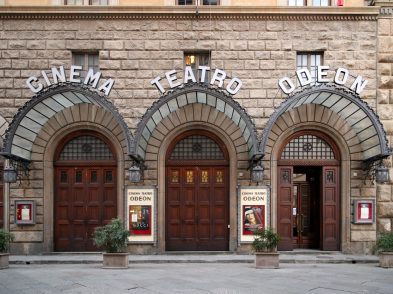If not for the tragic death in 1933 of her “radiant” seven-year-old son, Gian Clemente Bayard Origo, known as Gianni, from tubercular meningitis, Anglo-American biographer and author Iris Origo may never have taken up writing seriously. To fill the void left by his death, she began by writing the biography of the tormented Italian poet, Giacomo Leopardi (1798-1837), which received critical acclaim on its publication in 1935. She then wrote other biographies, among them the sorrowful story of Lord Byron’s illegitimate daughter (Allegra), the saga of the love affair between Byron and Teresa Guiccioli (The Last Attachment) and the fascinating account documenting the fourteenth-century world of Francesco di Marco Datini (The Merchant of Prato).
As she tells us in her autobiography Images and Shadows: Part of a Life, Iris Origo was born in England on August 15, 1902, the only child of diplomat William Bayard Cutting Jr., who came from an old-money Long Island family, and Lady Sybil Cuffe, whose father was an Anglo-Irish peer. From the time William Cutting was diagnosed with tuberculosis, the family travelled widely in search of warmer climates until he died in Egypt, when Iris was only eight years old. Fulfilling her husband’s wish that their daughter grow up “somewhere where she does not belong” to allow her to become cosmopolitan and free her from patriotism, Lady Sybil used part of the considerable Cutting fortune left to her to buy Villa Medici, the spectacular villa in Fiesole designed by Michelozzo in the fifteenth century for Cosimo de’ Medici. As part of the cliquish world of the Anglo-American expatriates residing in Florence at the time, mother and daughter mixed with, among others, Mary and Bernard Berenson, Edith Wharton, Janet Ross and Harold Acton.
At 18, Iris met and fell in love with Antonio Origo, the handsome and charming illegitimate son of Marchese Clemente Origo. Obstructed by Lady Sybil, who disapproved of the relationship because Origo was Italian, Catholic and 10 years Iris’ senior, the couple did not marry until four years later, in 1924. They had two daughters in addition to their son, and were together for 52 years, until Antonio Origo’s death in 1976.
To escape the petty intrigues of the foreign community in Florence, the newlywed couple decided to live in the country, where Antonio could farm, his great passion in life. Just before their wedding, by pooling their resources, they purchased La Foce, a long-uninhabited, desolate, sixteenth-century brick manor house with no amenities, surrounded by 3,500 hectares of neglected, infertile land in Val d’Orcia, five miles from Chianciano.
Although complete novices in estate management, the couple had a clear vision of what it could become and for the next 20 years, they worked tirelessly to modernise this almost feudal property. They added roads and irrigation, put in bathrooms and fountains, built a nursery school for the tenant farmers’ children, a hospital, a chapel and a small cemetery (where both are buried alongside Gianni). With the help of some financing from the state, they increased the number of farmhouses on the land from 25 to 57 and constructed an oil mill, grain silo, dairy, wash-house and a small store. Iris also employed English architect Cecil Pinsent, who had created her mother’s garden at Villa Medici, to design hers.
The collapse of Mussolini’s government and the landing of the Allied forces in southern Italy placed La Foce in the pathway of the retreating German army. During this dangerous period, the Origos took in refugee children, whom they housed in what was called the Casa dei Bambini, and taking considerable risks, sheltered and aided many escaping Allied prisoners of war and partisans on the run. With no embellishments, Iris described these experiences in her book, War in the Val D’Orcia: An Italian War Diary, 1943-1944, published in 1947, one of the very few eyewitness accounts of war-torn Italy written by a woman. Once the war was over, Iris worked for the Red Cross in Rome, first renting, then buying the Palazzo Orsini (built atop a Roman theatre, it is currently for sale). She also continued to commute to La Foce, where she had set up an orphanage.
Tall and slim, as a young woman she was an attractive brunette with periwinkle blue eyes. Perceived by some to be haughty, she always dressed impeccably, with never a hair out of place. She spoke very quickly and sometimes seemed to issue orders rather than make requests. As she grew older, her health was not good, although this never stopped her from writing. On June 28, 1988, at the age of 86, she died of cancer. Almost as an epitaph, she once confessed “I am not really an ‘intellectual’; all my life has been bound up with my affections.” Fortunately, some of them she shared with us.
La Foce, villa and gardens
La Foce is one of the most important twentieth-century gardens in Italy, a horticultural masterpiece. The gardens feature elegant boxwood-edged beds, green enclosures that gave shape to shrubs, perennials and vines, soaring cypress walks, cyclamens, lawns, and wildflower meadows. Today the estate is run by Iris Origo’s daughters Benedetta and Donata. Guided tours of the gardens take place on Wednesdays: 3pm-7pm, April to September; 3pm-5pm, October to March. La Foce hosts a chamber music festival each summer, Incontri in Terra di Siena. For information, contact La Foce (Strada della Vittoria 61, Chianciano Terme, SI) at 057/869101, info@lafoce.com or consult www.lafoce.com. Read about the Palazzo Orsini at www.gkitalianproperty.com/docs/Sunday%20Times.pdf.
Lady Sybil Marjorie Cuffe
Born in 1879, Lady Sybil Marjorie Cuffe, Iris Origo’s mother and a member of the so-called exiles in paradise in Florence, where petty jealousies and hot passions were not unusual, was probably best known for the men she married and for her self-obsession and hypochondria. After William Bayard Cutting Jr. died, the wealthy young widow made Villa Medici her home where, if she felt up to it, she entertained frequently, receiving local expatriates and visitors for tea every Sunday afternoon. Being friends with both Mary and Bernard Berenson did not prevent her from having a brief affair with Bernard sometime around 1914. At the time, his wife Mary did not appear to object too strongly, believing Lady Sybil to be an improvement on his former lover. Her unlikely and mismatched second marriage took place in 1918. This time, to Mary Berenson’s chagrin, she married Geoffrey Scott (1884-1929), Bernard Berenson’s secretary and an architectural historian. They divorced over his affair with Vita Sackville West. Her third husband, essayist Percy Lubbock (1879-1965), a close friend and editor of Henry James, proved to be a better choice than Scott, although Iris did not particularly like him. The couple lived together in Gli Scafari, on the Gulf of La Spezia, until they moved to Switzerland to escape World War II, where Lady Sybil died on December 26, 1943.







